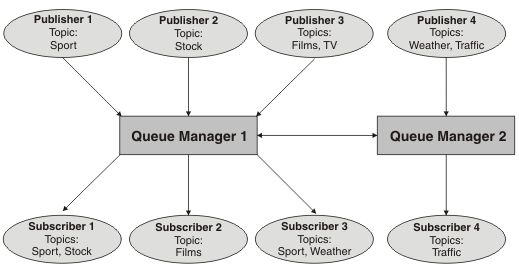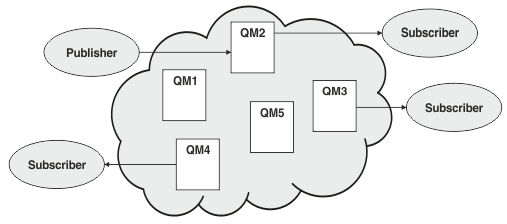Distributed publish/subscribe networks
Each queue manager matches messages published to a topic with the locally created subscriptions that have subscribed to that topic. We can configure a network of queue managers so that messages published by an application connected to one queue manager are delivered to matching subscriptions created on other queue managers in the network. This requires additional configuration over simple channels between queue managers.
A distributed publish/subscribe configuration is a set of queue managers connected together. The queue managers can all be on the same physical system, or they can be distributed over several physical systems. When you connect queue managers together, subscribers can subscribe to one queue manager and receive messages that were initially published to another queue manager. To illustrate this, the following figure adds a second queue manager to the configuration described in Example of a single queue manager publish/subscribe configuration.- Queue manager 2 is used by Publisher 4 to publish weather forecast information, using a topic of Weather, and information about traffic conditions on major roads, using a topic of Traffic.
- Subscriber 4 also uses this queue manager, and subscribes to information about traffic conditions using topic Traffic.
- Subscriber 3 also subscribes to information about weather conditions, even though it uses a different queue manager from the publisher. This is possible because the queue managers are linked to each other.

We can manually connect queue managers in a parent and child hierarchy, or we can create a publish/subscribe cluster and let IBM MQ define much of the connection detail for you. We can also use both topologies in combination, for example by joining several clusters together in a hierarchy.
Overview of publish/subscribe clusters
A publish/subscribe cluster is a standard cluster with one or more topic objects added to the cluster. When you define an administrative topic object on any queue manager in a cluster, and make that topic object clustered by specifying a cluster name, then publishers and subscribers to the topic can connect to any of the queue managers in the cluster, and messages published are routed to the subscribers over cluster channels between queue managers.

- direct routing
- topic host routing
When you configure a direct routed clustered topic, messages published on one queue manager are sent directly from that queue manager to every subscription on any other queue manager in the cluster. This can provide the most direct path for publications but does result in all queue managers in a cluster becoming aware of all other queue managers, each potentially having cluster channels established between them.
When we use topic host routing, messages published on one queue manager are sent from there to a queue manager that hosts a definition of the administered topic object. That topic host queue manager routes the message on to every subscription on any other queue manager in the cluster. If the publishers or subscribers are not located on the topic host queue managers, this results in a longer route for publications. However, the benefit is that only the topic host queue managers become aware of all other queue managers in the cluster, and potentially have cluster channels established with them.
For more information, see Publish/subscribe clusters.
Overview of publish/subscribe hierarchies
A publish/subscribe hierarchy is a set of queue managers connected by channels into a hierarchical structure. Each queue manager identifies its parent queue manager, as described in Connect a queue manager to a publish/subscribe hierarchy.
Publishers and subscribers to a topic can connect to any queue manager in the hierarchy, and messages flow between them using the hierarchical queue manager connectivity.

In the previous figure, publications delivered to the subscribers on QM3 and QM4 have been routed from QM2 to QM1 and then onto QM3 and finally QM4.
Hierarchies give you direct control over the relationships between every queue manager in the hierarchy. This allows fine-grained control over the routing of messages from publishers to subscribers, and is especially useful when routing between queue manager networks with restricted connectivity. We should give careful consideration to the availability and capability of every queue manager through which a message is routed on its way from publisher to subscribers.
For more information, see Publish/subscribe hierarchies.
Publication distribution between queue managers
In addition to the routing choices, there are two approaches to distributing publications across a network of queue managers:- Only send publications from one queue manager to the queue managers that currently host a subscription for that publication.
- Send each publication to all queue managers, and let them match it against their subscriptions.
The former results in publication messages only being sent where necessary, but does require a level of subscription knowledge to be shared between queue managers. The latter does not require subscription knowledge being shared, but can result in unnecessary publication messages being sent between queue managers.
By default, IBM MQ uses the former method, in which publications are only sent to queue managers that have subscriptions for them. The subscription knowledge is propagated between queue managers in the form of proxy subscriptions. It depends on the distribution and lifetime of subscriptions, and the frequency of publications, as to which is the most efficient to use in a distributed publish/subscribe topology. See Subscription performance in publish/subscribe networks.
- Publish/subscribe clusters
A publish/subscribe cluster is a standard cluster of interconnected queue managers, on which publications are automatically moved from publishing applications to subscriptions that exist on any of the queue managers in the cluster. There are two options for routing publications across a publish/subscribe cluster: direct routing and topic host routing. The routing you choose depends upon the size and expected activity patterns for the cluster. - Publish/subscribe hierarchies
You build a publish/subscribe hierarchy by linking the queue managers together using channels, then defining a child-parent relationship between pairs of queue managers. A message flows from a publisher to the subscriptions through the direct relations in a hierarchy. Note that this might mean multiplehops
to get there. - Proxy subscriptions in a publish/subscribe network
A proxy subscription is a subscription made by one queue manager for topics published on another queue manager. A proxy subscription flows between queue managers for each individual topic string that is subscribed to by a subscription. You do not create proxy subscriptions explicitly, the queue manager does so on your behalf. - Publication scope
When you configure a publish/subscribe cluster or hierarchy, the scope of a publication further controls whether queue managers forward a publication to remote queue managers. Use the PUBSCOPE topic attribute to administer the scope of publications. - Subscription scope
The scope of a subscription controls whether a subscription on one queue manager receives publications that are published on another queue manager in a publish/subscribe cluster or hierarchy, or only publications from local publishers. - Topic spaces
A topic space is the set of topics on which we can subscribe and publish. A queue manager in a distributed publish/subscribe topology has a topic space that potentially includes topics that have been subscribed and published to on connected queue managers in that topology.
Parent topic: Publish/subscribe messaging
Related concepts
Related information